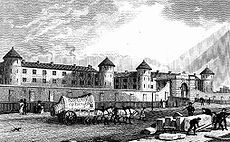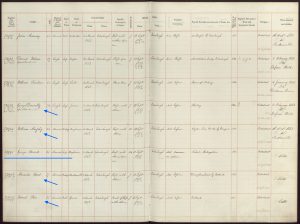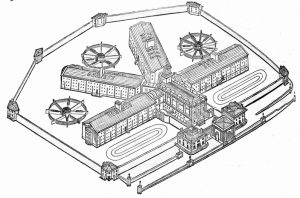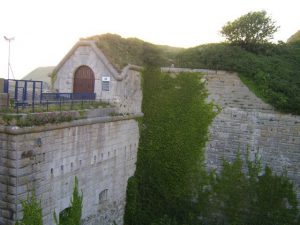George Brand in Prison





 Prior to his transportation George was moved back to Portland and it was at this point George appears to have parted company with his co-conspirators.12,13 The Portland Prison Governor’s Journal dated 27 January 1855 states that the convict ship ‘Stag’ sailed for Plymouth with 85 convicts to begin their sea voyage to Australia.13 It is easy to envisage George being sent from prison to prison, so far from his family in Scotland knowing that his sentence of transportation would only see him travel a distance unable to be comprehended.
George Brand: A Convict Success Story - Part 1
George Brand: A Convict Success Story - Part 2
George Brand: A Convict Success Story - Part 4
George Brand: A Convict Success Story - Part 5
Prior to his transportation George was moved back to Portland and it was at this point George appears to have parted company with his co-conspirators.12,13 The Portland Prison Governor’s Journal dated 27 January 1855 states that the convict ship ‘Stag’ sailed for Plymouth with 85 convicts to begin their sea voyage to Australia.13 It is easy to envisage George being sent from prison to prison, so far from his family in Scotland knowing that his sentence of transportation would only see him travel a distance unable to be comprehended.
George Brand: A Convict Success Story - Part 1
George Brand: A Convict Success Story - Part 2
George Brand: A Convict Success Story - Part 4
George Brand: A Convict Success Story - Part 5
Do you have a convict ancestor? Click on the below image to start searching for your convict ancestors at Findmypast today.
Bibliography
Image Credit: Pentonville Prison Separate System Design. Public Domain, By Joshua Jebb or employee. https://commons.wikimedia.org/w/index.php?curid=2993483. Accessed 5 June 2016.
Image Credit: Portland Prison. Public Domain, https://upload.wikimedia.org/wikipedia/commons/8/8e/Portland_Prison_- _geograph.org.uk_-_214496.jpg. Accessed 15 June 2016.
- 1. Findmypast.com.au. England & Wales, Crime, Prisons & Punishment, 1770-1935. Piece Number 33, Series PCOM2, Millbank Prison, Middlesex: register of prisoners. https://search.findmypast.com.au/record?id=tna%2fccc%2f2b%2fpcom2%2f00855318. Accessed 5 June 2016.
- 2. Findmypast.com.au. Millbank Prison Registers: Male Prisoners, Volume 5, England & Wales, Crime, Prisons & Punishment, 1770 1935, Series HO24, Piece Number 5. https://search.findmypast.com.au/record?id=tna%2fccc%2f2d%2fho24%2f00037607. Accessed 5 June 2016.
- 3. Waymarking.com. ‘Millbank Prison Millbank London UK’. https://www.waymarking.com/waymarks/WMNB72_Millbank_Prison_Millbank_London_UK. Accessed 13 June 2016.
- 4. En.wikipedia.org. ’Millbank prison’. https://en.wikipedia.org/wiki/Millbank_Prison. Accessed 13 June 2016.
- 5. Findmypast.com.au. England & Wales, Crime, Prisons & Punishment, 1770-1935. Piece Number 33, Series PCOM2, Millbank Prison, Middlesex: register of prisoners. https://search.findmypast.com.au/record?id=tna%2fccc%2f2b%2fpcom2%2f00855318. Accessed 5 June 2016.
- 6. Capitalpunishmentuk.org. ‘Pentonville’. https://www.capitalpunishmentuk.org/penton.html. Accessed 13 June 2016.
- 7. Gutsandgore.co.uk. ‘Pentonville’. https://www.gutsandgore.co.uk/notorious-prisons/pentonville/ . Accessed 13 June 2016.
- 8. Findmypast.com.au. England & Wales, Crime, Prisons & Punishment, 1770-1935. Piece Number 65, Series PCOM2, Pentonville Prison, Middlesex: register of prisoners, page 34. https://search.findmypast.com.au/record?id=tna%2fccc%2f2b%2fpcom2%2f00893185. Accessed 5 June 2016.
- 9. Portlandhistory.co.uk. ‘HM Prison Portland’. https://www.portlandhistory.co.uk/hm-prison-portland.html. Accessed 10 June 2016.
- 10. Dartmoor-prison.co.uk. ‘History of Dartmoor Prison’. https://www.dartmoor-prison.co.uk/history_of_dartmoor_prison.php. Accessed 13 June 2016.
- 11. Findmypast.com.au. Home Office: Convict Hulks, Convict Prisons and Criminal Lunatic Asylums: Quarterly Returns of Prisoners, Convict Prison at Dartmoor, Devon. Series HO8, Piece Number 118. https://search.findmypast.com.au/record?id=tna%2fccc%2f2a%2fho8%2f01248079. Accessed 5 June 2016.
- 12. Ancestry.com. Western Australia, Australia, Convict Records, 18461930 [database on-line]. Provo, UT, USA: Ancestry.com Operations, Inc., 2015. Original Data: Convict Records. State Records Office of Western Australia, Perth, Western Australia, Australia. Convict Department, Registers: Reference Number: ACC 1156/R18. Accessed 16 May 2016.
- 13. Findmypast.com.au. England & Wales, Crime, Prisons & Punishment, 1770-1935. Piece Number 357, Series PCOM2, Portland Prison, Dorset: governor’s journals, page 245. https://search.findmypast.com.au/record?id=tna%2fccc%2f2b%2fpcom2%2f01241410. Accessed 5 June 2016.

Hello Megan,
It is clear to see from this page that you are a history buff. I enjoyed reading the information and history about George Brand. I found that you have provided a great deal of historical context and specific information regarding dates, details on the prisons and images. I enjoyed reading this page and hope you continue.
Lee
Hi Lee,
I’m so glad you enjoyed it. I love my family history but sometimes others aren’t as interested in my family history. I like weaving the context of the era into my history because it’s then not only about my history but a shared history. I hope by sharing my family history I can inspire others to find out about theirs. Please feel free to look around my site and read what inspires you.
Regards,
Megan
What an awesome website. I like your theme you have really out done yourself. It works well with your niche of family history and history itself. I learnt something new from your post a little bit of history. It may come in handy on my next trivia night. This post will be very useful to those who are searching for their own history.
Thank you Charlotte. I really love Family History. I love working out who my ancestors were. To be descended from an Australian Convict is now considered a badge of honour in Australia. To think that I’m a English born descendant of an Australian convict is amazing – can’t be too many of us around. Would you like to learn to search your family history?